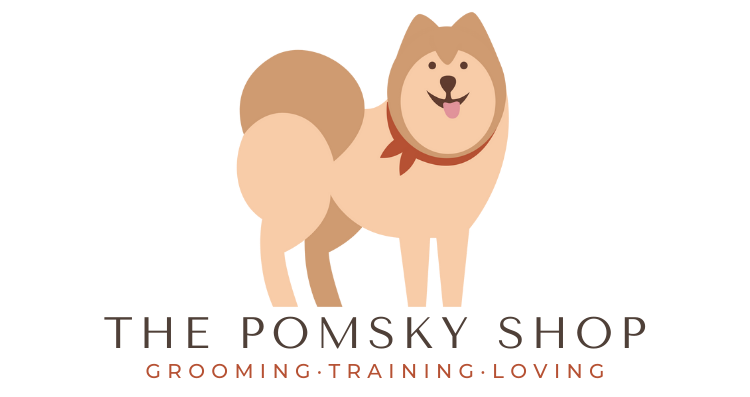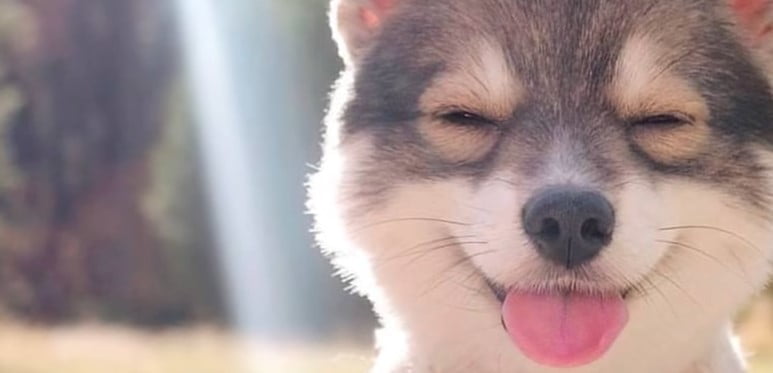Are you the proud owner of an adorable Pomsky? Good for you! Pomsky is one of the crossbreed dogs gaining popularity with dog lovers. Particularly because of their cute looks, it’s hard not to fall in love with them at first sight. Overall the Pomsky is a great cross-breed and can make a great pet. So if you’re looking to get a Pomsky, you may want to know more about them, including about the Pomsky temperament.
Pomskies are a relatively new breed, resulting from a Siberian husky and the Pomeranian. These furry creatures are simply adorable and if you’ve ever wondered why your Pomsky behaves in a certain way, it has a lot to do with genetics of course. So if you wish to know more about them you are in the right place as we’ll be sharing with you what you need to know about them.
Whether you already are a furry baby parent or are looking to get your very first dog pet, Pomskies are a superb choice. However, as a first-time owner, doing a little research is always a good idea, we all know our furry children represent a responsibility so if you are up to the challenge, keep reading and get to know all about your Pomsky temperament and behavior.
History and Origins
Like many of the designer crossbreeds, the Pomsky originated in the United States. Since it is a relatively new dog breed, the looks and traits are not yet established. This is why it’s important to look at the individual breeds making up the Pomsky.
The two breeds that go into the formation of the Pomsky are the Pomeranian and the Siberian Husky.
Pomsky Temperament FAQs
Is the temperament the same for all Pomskies?
A Pomsky is a cross between a Siberian Husky and a Pomeranian. The temperaments of these two breeds have few similarities. Ultimately, the temperament of a Pomsky will vary for each dog. You never know which temperament – Husky or Pomeranian – is dominant until you meet the dog in person.
But there are some characteristics that a Pomsky will always have: it is bound to be an energetic, sociable, and very affectionate family dog. Read on to find out more.
Are Pomskies house dogs?
Pomskies are house dogs, so they should be kept inside the house. They are also great for apartment living. Do ensure that your dog gets enough exercise and that you take it out regularly or participate in activities such as dog training.
Are Pomskies aggressive?
As a Pomsky owner, you must assert yourself as the alpha of the relationship or they will try to take on that role. Pomskies are not aggressive at all, they are loving, caring and funny dogs that love to cover their owners with kisses.
Are Pomsky good family dogs?
Pomskies are very energetic and entertaining. They love attention and always like to be included in family activities. They are great dogs when they are with children or family but they can get lonely if they are left alone for long periods of time.
Are Pomsky high maintenance?
Maintenance: If things go right and they often do, the Pomsky can be an easier dog to handle compared to its parents the Siberian Husky and Pomeranian. They often don’t require the living space and backyard size that huskies need for running and getting out their energy.
How do you calm down a Pomsky?
Just like humans, dogs sometimes feel stressed or anxious, and having a relaxing, meaningful massage is a great way to relieve some of those stress hormones. To get them to calm down, try rubbing the parts of their back that seem tense or stiff.
What are the characteristics of a Pomsky?
Life Span
As pomskies have been around for less than 10 years, experts can only estimate their average life expectancy. But based on both of their parent breeds, it’s generally expected that healthy pomskies should live anywhere from 13 to 15 years.
Intelligence & Trainability
These dogs are very intelligent, but they inherit their parents’ temperaments and can be significantly harder to train than other dogs.
Temperament
It can be unpredictable, as it really depends on each dog’s parents, but on the whole, they’re described as gentle, playful, and confident.
Activity Level
They’re very active dogs that love to play with their owners but be warned that these little guys need to stay busy, otherwise they get bored and can develop destructive behavior.
Size
They’re generally 10-15 inches high (25-38 cm) and can reach up to 20-30 lbs. (9-14 kg). In some rare cases, they’ve been known to grow as big as a Husky.
Caring
- Exercise: these dogs need at least a 20-minute walk in the morning, and a longer one in the afternoon, plus one or two play sessions during the day.
- Feeding: they need regular, healthy food in moderate quantities, however, they’re not fussy and have no special requirements.
- Grooming: they have double coats with long, silky hair, and need daily brushing during the shedding seasons, which all up is about six months a year. For the rest of the time, their coats need brushing 3-5 times a week.
Children & other Pets
Some breeders say these dogs are the perfect family dog, while others suggest you should pay attention to small children, and recommend Pomskies only for single people and families with teenagers. A Pomsky can get on well with other pets if you introduce them to each other when the dog is still very young.
Pomsky Temperament
Like most crossbreeds, the temperament of a Pomsky depends on the parents and how they have been bred and reared.
The Pomeranian: Germany
The Pomeranian was developed by reducing the size of larger spitz types through selective breeding. While this dog originated in Germany, it was developed in England to be the size we know today. The Pom came to England in the 18th century when Queen Charlotte brought her court dogs with her from Germany. At this point, her dogs weighed about 9-14kgs but they still became firm favorites at court and by the 19th century they turned into a popular Victorian breed. In 1888, Queen Victoria was visiting Italy when she saw a few much smaller spitz dogs. She brought them home and crossed them with her existing dogs. Six of her dogs were shown at Crufts in 1891 (and not surprisingly, won). In the years that followed, the breed was intentionally shrunk smaller until it reached the size we know today.
The Pomeranian is a surprisingly active little dog who can excel at training. They are sociable, friendly, and outgoing. Sometimes they don’t realize they are tiny dogs at all!
Siberian Husky: Russia
This is one of the oldest and purest of the northern-sled dogs and it is said that they have been bred in their native Siberia as long as 3000 years ago. To the natives of the area, these dogs were key to their survival and were selectively bred to be able to carry loads over long distances at great speeds. The dogs lived alongside the families and so only non-aggressive dogs that were friendly towards the children were used in this ancient breeding program, along with only the very best sled dogs.
The Siberian Husky is very much a working dog at heart. They are however friendly, gentle, and alert. They are not dogs who will ever shine in the obedience ring, as they are independent, scorn training, and are selectively bred for one purpose. They are active and agile, and as such can be difficult to keep as a companion dog. They are quiet most of the time as they don’t bark, but they do howl which is a joy for most huskies (but not for their neighbors).
Pomsky

The Pomsky can have any combination of the two breeds in their appearance, behavior, and temperament.
Considering two breeds that make up the Pomsky, there can be huge variations in personality and temperament. With the best of both breeds, you should get a sociable, friendly, although independent, dog who will enjoy a lot of exercise and be relatively trainable.
The temperament of a Pomsky seems to be more consistent when they are first crossed. As a line is successively bred, they can be either bred back to one of the original breeds (and so strengthen either the Pomeranian or the Husky personalities) or be bred to another Pomsky – in which case there is less predictability in temperament (and in-breeding becomes more of a potential issue).
Finding a responsible breeder of this cross is difficult as they are often bred for looks and not for health or behavior.
Pomsky Temperament Top Characteristics
- Intelligent
- High energy
- Extroverted
- Loving
Behavioral Traits
- Possessive
- If left alone for long periods of time can be destructive
- Small Dog Syndrome
Trainability Tips
- Start training at an early age to curb behavioral problems in the future
- Focus on plenty of socialization to combat possessiveness
- Needs plenty of exercises to burn energy, such as walks or playing with toys



